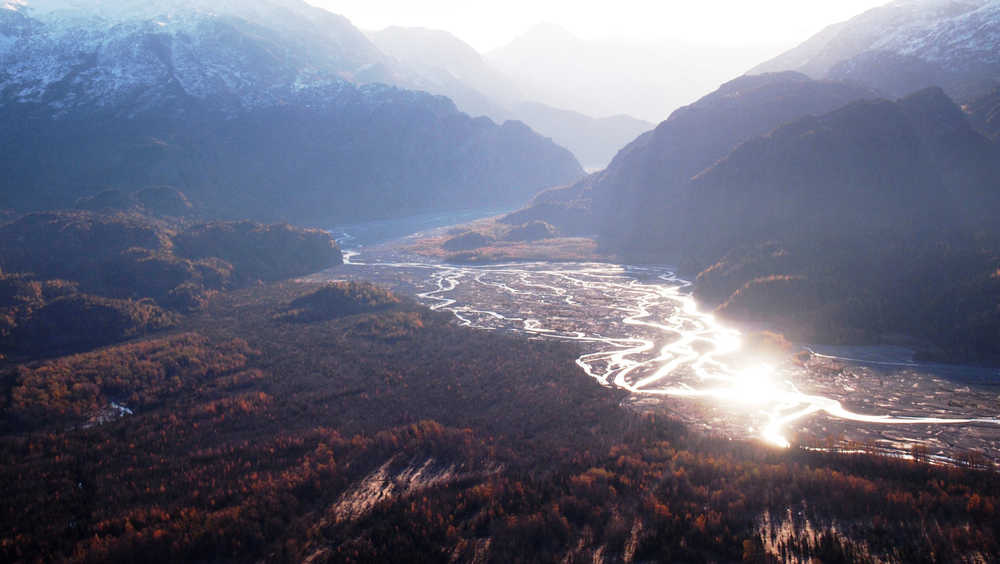Did you know that the Kenai Peninsula has 1,800 miles of anadromous streams and rivers that flow into our surrounding salt waters from 374 outlets? We are indeed blessed with an abundance of salmon, Dolly Varden and hooligan habitat.
But not all streams are created equally. Some are fed by meltwater from glaciers and persistent snow fields high in the Kenai Mountains. Certainly the largest example of a mostly glacial system is the Kenai River, the only river that receives water from both the Harding and Sargent Icefields in its upper watershed. Further downstream, it receives substantial nonglacial input from the Killey, Funny and Moose Rivers, all of which originate on the Kenai National Wildlife Refuge.
The largest nonglacial stream on the peninsula is the Anchor River, which presumably receives its inputs from precipitation, groundwater and surrounding peatlands. A 2015 article published by Mike Gracz of the Kenai Watershed Forum sheds some light on what the relative contribution of those sources might be. Using two different methods, Gracz and his coauthors showed that 55 percent of dry season flow in Limpopo Creek, an Anchor River tributary, originated from adjacent peatlands. Peat stores water well and so buffers against dry seasons and drought.
Whether a stream originates from glacial or nonglacial sources has real implications for salmon. The source determines its vulnerability, and therefore salmon’s vulnerability, to our rapidly warming climate. Since 1968, available water, which accounts for precipitation and evapotranspiration, has declined by 60 percent on the western Kenai Peninsula. Ed Berg, retired refuge ecologist, estimates that roughly one-third of the decline is due to increasing temperatures and two-thirds due to decreasing precipitation.
For non-glacial streams, increasing air temperatures is a big deal. It directly corresponds with water temperatures. Sue Mauger, with the Cook Inletkeeper, found that 47 of 48 nonglacial streams she monitors on the Kenai Peninsula and in the Mat-Su experienced temperatures in July that cause sublethal stress in salmon. This past summer, she recorded the highest temperature in the Anchor River since 2002 on July 18, reaching 70 degrees. On the Deshka River, water temperatures reached 77 degrees! Given that salmon spawning is impacted at 55 degrees, these temperatures don’t bode well.
In contrast, glacially-fed rivers are robust against varying air temperatures. Water temperatures at the Kenai Lake outlet in Cooper Landing tend to hover in the low 50s in July. Robert Ruffner (Kenai Watershed Forum) says that lower Kenai River temperatures may exceed 60 degrees in July during short periods of calm weather, but will quickly drop again when winds pick up, presumably from mixing strata in Kenai and Skilak lakes.
But more glacial meltwater is not necessarily a good thing. A long-term study by the Alaska Department of Fish and Game showed that sockeye recruitment in Skilak Lake was depressed by the additional input of glacial meltwater during the 1990s. More water, more silt, higher turbidity, reduced light penetration, reduced phytoplankton abundance, reduced copepod biomass and, finally, reduced salmon recruitment. What a complex web!
Although it’s difficult to generalize, I suspect that nonglacial streams are more vulnerable than glacial streams to climate warming in the short term. Not only are air temperatures increasing rapidly, but shorter periods of ice cover mean extended periods for those waters to receive solar radiation. Also, spruce trees killed by spruce bark beetles gone amuck and thin-leaf alder defoliated by exotic green alder sawflies mean less canopy cover and more solar radiation.
And then the peatlands, which we have learned buffer nonglacial streams during dry seasons, are themselves drying. Berg has demonstrated that many of our Sphagnum peatlands, which have persisted on the Kenai landscape for more than 8,000 years, are being invaded by woody shrubs such as dwarf birch in just the past 40 years. Wetlands in the Kenai Lowlands have lost 6-11 percent of their surface area per decade over the same period.
Glacially-fed streams, on the other hand, are good to go as long as our icefields persist. Given that the Harding Icefield may be as deep as a mile, we’ve got time. Nonetheless, the Harding Icefield has shrunk more than 60 feet in average elevation since the 1950s, and estimates of lost surface area have been recently revised from 5 percent to 11 percent over that same period. While scrutinizing Google Earth, I noticed many short, high-gradient mountain streams flowing into Resurrection Bay that originated from snow fields or glaciers in satellite imagery taken 3 decades ago, now appear to be discontinuous from anything white during the summer months.
So what to do other than wring our hands? Mauger uses thermal imagery to identify areas with cold seeps in the Anchor River that the Kachemak Heritage Land Trust then purchases to retain a source of “refrigeration” in those warming waters. Restoring and maintaining riparian vegetation is also an easy way of providing shade to reduce solar input into streams.
A less obvious but smart solution to changing environmental conditions is to maintain high genetic diversity in our salmon populations. As the focus in recent years has been on sustaining high harvest levels, there is pressure to enhance our fisheries with hatchery-raised fish. While there is nothing inherently wrong with the practice of “ranched” salmon, it can become a problem if we ignore the fate of small native salmon stocks in our smaller streams (like Slikok Creek) because overall escapement goals are being reached. As in farming, it’s not wise to grow your crops as a monoculture.
The bottom line is that sustaining salmon on the Kenai Peninsula in a rapidly warming climate will not be accomplished by tried-and-true management practices of the past. We’re going to need creative solutions to this wicked problem.
John Morton is the supervisory biologist at Kenai National Wildlife Refuge. You can find more information about the refuge at http://kenai.fws.gov or http://www.facebook.com/kenainationalwildliferefuge.

